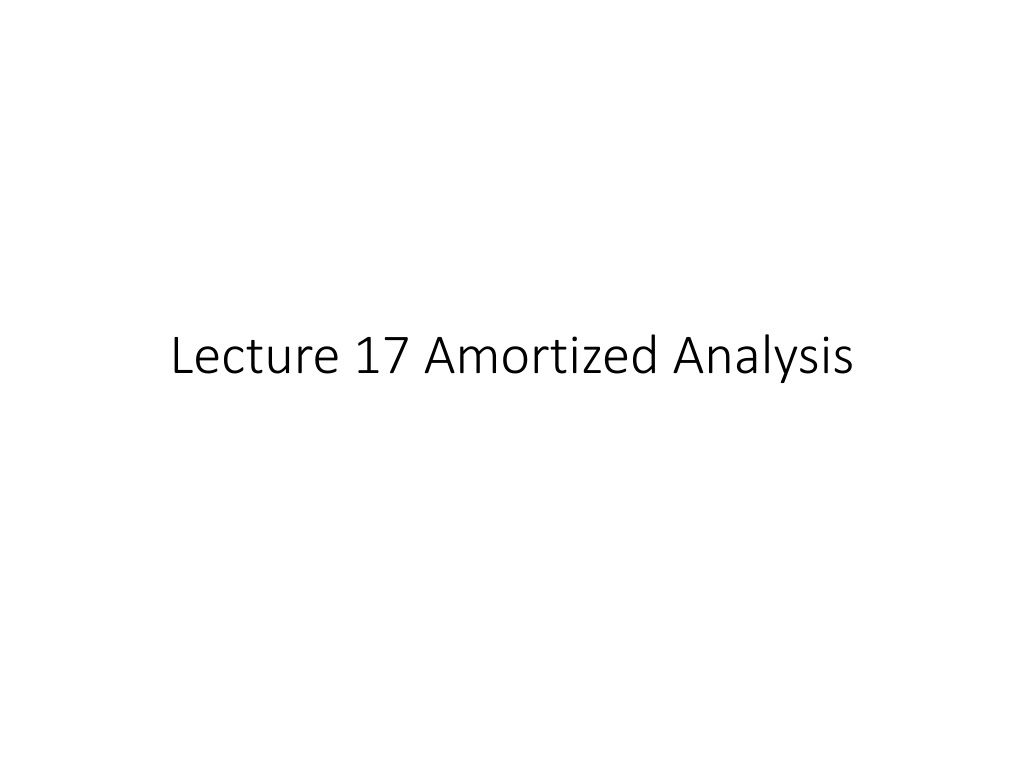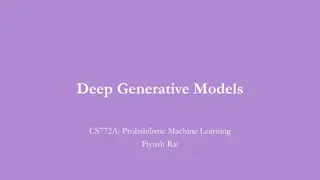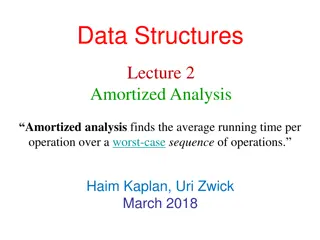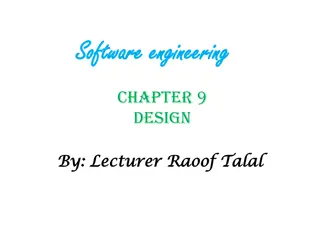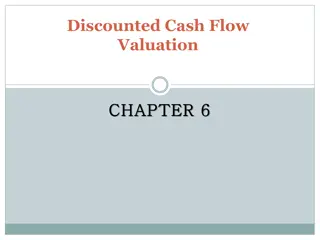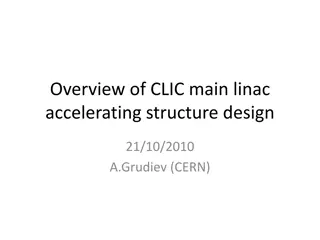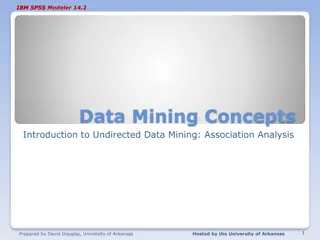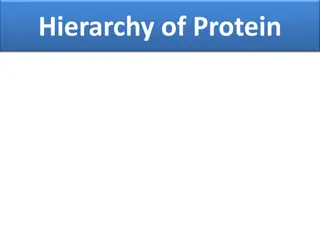Amortized Analysis and Data Structure Design
Explore the concept of amortized analysis, potential functions, and data structure design techniques such as dynamic array resizing and disjoint sets. Compare different methods for analyzing algorithms and handling data structures efficiently.
Download Presentation

Please find below an Image/Link to download the presentation.
The content on the website is provided AS IS for your information and personal use only. It may not be sold, licensed, or shared on other websites without obtaining consent from the author.If you encounter any issues during the download, it is possible that the publisher has removed the file from their server.
You are allowed to download the files provided on this website for personal or commercial use, subject to the condition that they are used lawfully. All files are the property of their respective owners.
The content on the website is provided AS IS for your information and personal use only. It may not be sold, licensed, or shared on other websites without obtaining consent from the author.
E N D
Presentation Transcript
Designing the Data-Structure We don t want to allocate new memory every time. Idea: when allocating new memory, allocate a larger space. Init() capacity = 1 length = 0 allocate an array a[] of 1 element Add(x) IF length < capacity THEN a[length] = x length = length+1 ELSE capacity = capacity * 2 allocate a new array a[] of capacity elements copy the current array to the new array a[length] = x length = length+1
Potential Argument Define a potential function , 0. When executing an expensive operation, the potential function should drop (Potential turns into energy) When executing a normal (light) operation, the potential function should increase (Energy turns into potential)
Potential Argument Amortized cost of an operation: Suppose an operation took (real) time Ti, changed the status from xi to xi+1 ??= ?? ?? + (??+1) Amortized Cost Potential Before Potential After Real Cost ? ? Claim: ?=1 ??= ?=1 ??+ ?1 (??+1)
Comparison between 3 methods Aggregate method Intuitive Does not work very well if there are multiple operations (e.g. stack: push/pop; heap: insert/pop/decrease key) Charging Method Flexible (you can choose what operations to charge on and how much to charge) Needs to come up with charging scheme Potential Method Very flexible Potential function is not always easy to come up with.
Data-structure for Disjoint Sets Problem: There are n elements, each in a separate set. Want to build a data structure that supports two operations: Find: Given an element, find the set it is in. (Each set is identified by a single head element in the set) Merge: Given two elements, merge the sets that they are in. Recall: Kruskal s algorithm.
Nave Implementation Using Linked Lists Merge: connects two linked lists, O(1) Find: needs to find the head/tail of the list, O(length) Using arrays a[i]: the set that item i is in Find: O(1) Merge(i,j): needs to update many entries in the array, O(length)
Representing Sets using Trees For each element, think of it as a node. Each subset is a tree, and the head element is the root. Find: find the root of the tree Merge: merge two trees into a single tree.
Example Sets {1, 3}, {2, 5, 6, 8}, {4}, {7} 7 2 4 1 8 6 3 5 Note: not necessarily binary trees.
Find Operation: Follow pointer to the parent until reach the root. 7 2 4 1 8 6 3 5
Merge Operation Make the root of one set as a child for another set 7 2 1 4 8 6 3 5
Running Time Find: Depth of the tree. Merge: First need to do two find operation, then spend O(1) to link the two trees. In the worst-case, the tree is just a linked list Depth = n.
Idea 1: Union by rank For each root, also store a rank When merging two sets, always use the set with higher rank as the new root. If two sets have the same rank, increase the rank of the new root after merging. 1 1 1 4 4 3 3 7
Idea 2: Path compression. After a find operation, connect everything along the way directly to the root. 2 2 6 8 6 7 8 Find(7) 3 5 3 5 4 4 7 1 1
Running Time Union by rank only Depth is always bounded by log n O(log n) worst-case, O(log n) amortized Union by rank + Path compression Worst case is still O(log n) Amortized: O(?(?)) = o(log*n)
